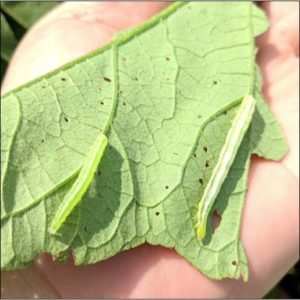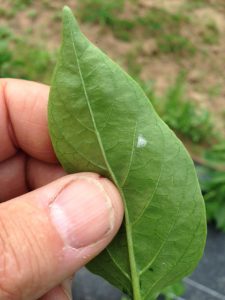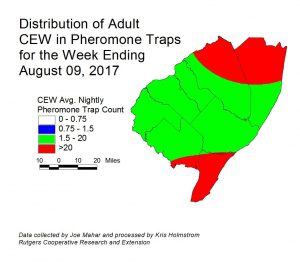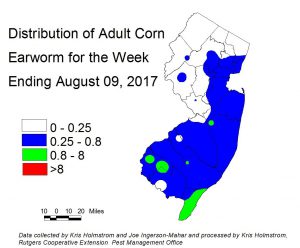Joe Ingerson-Mahar and Kris Holmstrom
This is an abbreviated edition of the IPM Update. The final IPM Update for the 2019 season will appear next week. Pest alerts will appear as needed.
Sweet Corn
European corn borer (ECB) remains at very low levels across most of the state, with a few moths (1 per night) being found in the Hillsborough and Milltown areas this past week. Late-season plantings are still at risk from ECB feeding but are likely to be minimal at this point. In the late-season corn borers tend to lay eggs on many different crops, including apples and eggplant, so do not be surprised that you find ECB on unexpected crops.
Corn earworm (CEW) numbers have fallen somewhat across the state with the generally cooler night-time temperatures of the past week. Counts in both blacklights and pheromone traps are highly variable across the state.
Blacklights – counts statewide range from 0 to 5 moths per night with larger numbers in the southern half of the state. Spray schedules range from 4 to 5-day to 3-day.
Pheromone traps – counts have also declined somewhat, due both to cooler weather and aging sweet corn. Plantings that are tasseling now will be the most attractive to CEW moths and these plantings should be on 3-day schedules, especially in South Jersey where despite declining numbers there is still a large reservoir of moths in the area. Highest counts seen are at Eldora with 58 moths per night and Beckett with 48 moths per night. The pheromone traps are showing a 4-day or 3-day schedule.
Fall armyworm pressure has been light in at least the southern part of the state. Infestations of less than 10% are the norm.
Peppers
Corn earworm numbers have been high in pheromone traps placed at pepper fields. Some injury has been found from these pests where insecticide applications have been backed off.
Beet armyworm continues to be a significant pest in the southernmost part of the state with counts at 73 per night at Jones Island and 32 per night at Pedricktown. Traps in Hammonton record less than 10 per night. Plant injury has occurred at counts under 5 per night.
Pepper weevil has become a widespread pest with now at least 8 farms infested in the Swedesboro, Glassboro, Hammonton and East V

Adult weevil on pepper
ineland areas. It is hard to estimate yield loss to weevils but most of these farms probably have light to moderate loss. Two of the farms had severe losses from weevils this year. Farms that are located near, or do business with, processors should routinely have yellow pheromone traps placed in high traffic areas on the farm and in fields. Weevils are most likely to be transported to the farm by hitchhiking on vehicles or on produce bins, though they are capable of spreading on their own to adjacent fields of solanaceous crops.
Other insect pests
Brown marmorated stinkbug has nearly become absent in blacklight trap catches. At this time of year, they are seeking ov
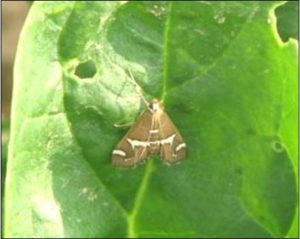
Hawaiian beet webworm on spinach
erwintering sites and do not present much of a problem for vegetable crops. Centerton had the highest nightly count of 2 for the past week.
Hawaiian beet webworm (HBWW) moths have been trapped in blacklights in South Jersey – Jones Island and Eldora. Though the numbers are light, farmers with spinach, beets, and chard should check their fields for the presence of webbing and feeding injury. These are small migratory moths usually occurring in mid-to-late summer. Their favored host is the pigweed, Amaranthus sp., but they are capable of causing defoliation and contamination to crops. Since they are migratory and have a short life cycle they can rapidly appear and cause extensive damage to crops unnoticed. There were isolated highly-infested weedy areas last year on vegetable farms in South Jersey.
